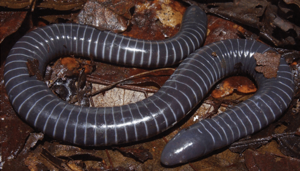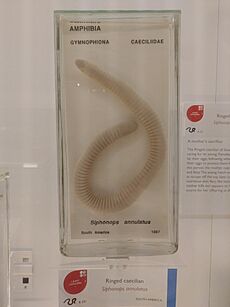Ringed caecilian facts for kids
Quick facts for kids Ringed caecilian |
|
|---|---|
 |
|
| Conservation status | |
| Scientific classification | |
| Genus: |
Siphonops
|
| Species: |
annulatus
|
| Synonyms | |
|
Caecilia interrupta Cuvier, 1829 |
|
The Siphonops annulatus, also known as the ringed caecilian, is a special type of caecilian. It belongs to the Siphonopidae family. This animal lives only in South America. It might be the most widespread land-dwelling caecilian species known.
Contents
What is a Ringed Caecilian?
The ringed caecilian is a worm-like amphibian. It can grow from about 28 to 45 centimeters (11 to 18 inches) long. Its body is shaped like a cylinder, a bit wider than it is tall.
Appearance
This creature is usually bluish-black or slate gray. It has special rings around its body. These rings are white or cream-colored. They go all the way around, except for the last few rings near its tail.
Amazing Skin Glands
Scientists from Brazil and the United States found something cool about these animals. They have different kinds of skin glands. Glands on their head make a slippery slime. This slime helps them burrow easily into the ground. Glands near their tail have strong chemicals. These chemicals are like the poisons found in other amphibians, such as toads. They help protect the caecilian from danger.
Behavior and Lifestyle
Caecilians are some of the least studied amphibians. We still have a lot to learn about how they behave. The ringed caecilian spends most of its life underground. It is a very good burrower.
Living Underground
Studies show that this species digs tunnels. These tunnels usually go no deeper than 20 centimeters (about 8 inches). The ringed caecilian has a very strong skull. This strong skull helps it push through the soil when it burrows.
Where Ringed Caecilians Live
The ringed caecilian is found in many places east of the Andes mountains. It was first found in Brazil. Now we know it also lives in Argentina, Bolivia, Colombia, Ecuador, French Guiana, Guyana, Paraguay, Peru, Suriname, and Venezuela.
Natural Homes
These caecilians live in many different places. They like warm, moist lowland forests. They can also be found in dry or moist savannas. You might see them in bushy areas or wet grasslands. They even live in farms, gardens, and areas where forests used to be.
Reproduction and Life Cycle
Mating for ringed caecilians happens between late August and early October. The females lay their eggs in November and December.
Unique Feeding Habits of Young
Baby caecilians have special spoon-shaped teeth. They use these teeth to feed on their mother's outer skin layer. The young feed all at once for about seven minutes. Then, they rest for three days. During this time, the mother grows a brand new outer skin layer for them to eat again. This amazing behavior is called maternal dermatophagy. It's also seen in a related caecilian from Africa. This suggests this behavior developed over 100 million years ago!
Milk-like Substance for Babies
A study from 2024 found another incredible thing. Researchers filmed mothers and their babies in a lab. The mothers stayed with their young. The babies would drink a white, thick liquid from their mother's body. This liquid was like milk and helped the babies grow very fast. It was full of fats and carbohydrates.
The mothers seemed to release this special liquid when the babies touched them or made sounds. The baby caecilians made high-pitched clicking sounds when they wanted milk. This is very unusual for amphibians! This milk-feeding might help the babies' bodies grow strong. It also helps their immune system, much like in mammals. Finding milk production in egg-laying caecilians is important. It shows how animals might have slowly changed from laying eggs to giving birth to live young.



